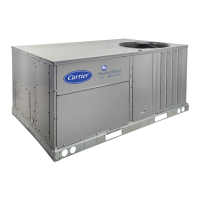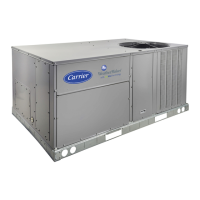ITEM
CCN
CCNA
CCNB
BAUD
BROD
TM.DT
OAT.B
ORH.B
OAQ.B
G.S.B
B.ACK
SC.OV
SCH.N
HOL. T
O.T.L.
OVEX
SPT.O
T58.0
GL.OV
Table 86 -- CCN Configuration
EXPANSION
CCN CONFIGURATION
CCN Address
CCN Bus Number
CCN Baud Rate
CCN BROADCST DEFINITIONS
CCN Time/Date Broadcast
CCN OAT Broadcast
CCN OARH Broadcast
CCN OAQ Broadcast
Global Schedule Broadcst
CCN Broadcast Ack'er
CCN SCHEDULES-OVERRIDES
Schedule Number
Accept Global Holidays?
Override Time Limit
Timed Override Hours
SPT Override Enabled ?
T58 Override Enabled ?
Global Sched. Override ?
I RANGEI UNITS I DEFAULT
0
3
- 239
- 239
-5
ON/OFF
ON/OFF
ON/OFF
ON/OFF
ON/OFF
ON/OFF
0 - 99
I YES/NO
0-4
0-4
YES/NO
YES/NO
YES/NO
HRS
HRS
I POINT
I CCNADD
CCNBUS
CCNBAUDD
CCNBC
OATBC
OARHBC
OAQBC
GSBC
CCNBCACK
SCHEDNUM
HOLIDAYT
OTL
OVR_EXT
SPT OVER
T58_OVER
GLBLOVER
On
Off
Off
Off
Off
Off
1
No
1
0
Yes
Yes
No
Accept Global Holidays? (HOL. T) -- If a device is broad-
casting the time on the bus, it is possible to accept the time yet
not accept the global holiday from the broadcast message.
Override Time Limit (O. T.L) -- This configuration allows
the user to decide how long an override occurs when it is initi-
ated. The override may be configured from 1 to 4 hours. If the
time is set to 0, the override function will become disabled.
Timed Override Hours (OV..EX) -- This displays the current
number of hours left in an override. It is possible to cancel an
override in progress by writing "0" to this variable, thereby
removing the override trine left.
StYF Override Enabled? (SPT.O) -- If a space sensor is
present, then it is possible to override an unoccupied period by
pushing the override button on the T55 or T56 sensor. This
option allows the user to disable this function by setting this
configuration to NO.
T58 Override Enabled? (158.0) -- The T58 sensor is a CCN
device that allows cooling/heating set points to be adjusted,
space temperature to be written to the rooftop unit, and the abil-
ity to initiate a timed override. This option allows the user to
disable the override initiated from the T58 sensor by setting
this option to NO.
Global Schedule Override? (GL.OV) -- If the control is set
to receive global schedules then it is also possible for the global
schedule broadcaster to call out an override condition as well.
This configuration allows the user to disable the global sched-
ule broadcaster from overriding the control.
Alert Limit Configuration E The ALLM submenu is
used to configure the alert limit set points. A list is shown in
Table 87.
StYF Low Alert Limit/Occ (SRL.O) -- If the space tempera-
ture is below the configurable occupied StYFLow Alert Limit
(SRL.O), then Alert 300 will be generated and the unit will be
stopped. The alert will automatically reset.
StYF High Alert Limit/Occ (SRH.O) -- If the space tempera-
ture is above the configurable occupied StYFHigh Alert Limit
(SRH.O), then Alert 301 will be generated and the unit will be
stopped. The alert will automatically reset.
StYF Low Alert Limit/Unocc (SRL. U) -- If the space tem-
perature is below the configurable unoccupied SPT Low Alert
Lrinit (SRL. U), then Alert 300 will be generated and the unit
will be stopped. The alert will automatically reset.
StYF High Alert Limit/Unocc (SRH. U) -- If the space tem-
perature is above the configurable unoccupied StYFHigh Alert
Lrinit (SRH. U), then Alert 301 will be generated and the unit
will be stopped. The alert will automatically reset.
EDT Low Alert Limit/Occ (SA.L.O) --If the space tempera-
ture is below the configurable occupied evaporator discharge
temperature (EDT) Low Alert Limit (SA.L.O), then Alert 302
will be generated and cooling operation will be stopped but
heating operation will continue. The alert will automatically
reset.
EDT High Alert Limit/Occ (SA.H.O) -- If the space temper-
ature is above the configurable occupied EDT High Alert Limit
(SA.H.O), then Alert 303 will be generated and heating opera-
tion will be stopped but cooling operation will continue. The
alert will automatically reset.
EDT Low Alert Limit/Unocc (SA.L. U) -- If the space tem-
perature is below the configurable unoccupied EDT Low Alert
Lrinit (SA.L. U), then Alert 302 will be generated and cooling
operation will be stopped but heating operation will continue.
The alert will automatically reset.
EDT High Alert Limit/Unocc (SA.H. U) -- If the space tem-
perature is above the configurable unoccupied EDT High Alert
Limit (SA.H. U), then Alert 303 will be generated and heating
operation will be stopped but cooling operation will continue.
The alert will automatically reset.
RAT Low Alert Limit/Occ (RA.L.O) -- If the return-air tem-
perature is below the configurable occupied RAT Low Alert
Lrinit (RA.L.O), then Alert 304 will be generated and internal
routines will be modified. Unit operation will continue but
VAV heating operation will be disabled. The alert will automat-
ically reset.
RAT High Alert Limit/Occ (RA.H.O) -- If the return-air
temperature is above the configurable occupied RAT High
Alert Limit (RA.H.O), then Alert 305 will be generated and
operation will continue. The alert will automatically reset.
RAT Low Alert Limit/Unocc (RA.L. U) -- If the return-air
temperature is below the configurable unoccupied RAT Low
Alert Lrinit (RA.L. U), then Alert 304 will be generated. Unit
operation will continue but VAV heating operation will be dis-
abled. The alert will automatically reset.
RAT High Alert Limit/Unocc (RA.H. U) -- If the return-air
temperature is above the configurable unoccupied RAT High
Alert Limit (RA.H. 12), then Alert 305 will be generated. Oper-
ation will continue. The alert will automatically reset.
RARH Low Alert Limit (R.RH.L) -- If the unit is config-
ured to use a return air relative humidity sensor ((bnfigura-
tion--+UNIT--+SENS--+RRI-I..S), and the measured level is
below the configurable RH Low Alert Lrinit (R.RH.L), then
Alert 308 will occur. The unit will continue to run and the alert
will automatically reset.
RARH High Alert Limit (R.RH.H) -- If the unit is config-
ured to use a return air relative humidity sensor ((bnfigura-
tion--+UNIT--+SENS--+RRHS), and the measured level is
above the configurable RARH High Alert Limit (R.R!-LH),
72

